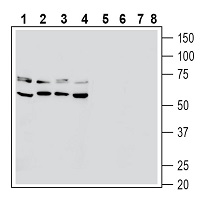Overview
- Peptide (C)GKETKSNYRVRVYQIPGK, corresponding to amino acid residues 106 - 123 of human RAGE (Accession Q15109). Extracellular, N-terminus.

 Western blot analysis of rat lung membranes (lanes 1 and 3) and mouse lung lysate (lanes 2 and 4):1, 2. Anti-RAGE (extracellular) Antibody (#ANR-176), (1:600).
Western blot analysis of rat lung membranes (lanes 1 and 3) and mouse lung lysate (lanes 2 and 4):1, 2. Anti-RAGE (extracellular) Antibody (#ANR-176), (1:600).
3, 4. Anti-RAGE (extracellular) Antibody, preincubated with RAGE (extracellular) Blocking Peptide (#BLP-NR176). Western blot analysis of human PANC-1 pancreatic carcinoma cell line lysate (lanes 1 and 5), human Jurkat T-cell leukemia cell line lysate (lanes 2 and 6), human THP-1 monocytic leukemia cell line lysate (lanes 3 and 7) and mouse BV-2 microglia cell line lysate (lanes 4 and 8):1-4. Anti-RAGE (extracellular) Antibody (#ANR-176), (1:600).
Western blot analysis of human PANC-1 pancreatic carcinoma cell line lysate (lanes 1 and 5), human Jurkat T-cell leukemia cell line lysate (lanes 2 and 6), human THP-1 monocytic leukemia cell line lysate (lanes 3 and 7) and mouse BV-2 microglia cell line lysate (lanes 4 and 8):1-4. Anti-RAGE (extracellular) Antibody (#ANR-176), (1:600).
5-8. Anti-RAGE (extracellular) Antibody, preincubated with RAGE (extracellular) Blocking Peptide (#BLP-NR176).
- Serveaux-Dancer, M. et al. (2019) Dis. Markers 2019, 2067353.
- Barbezier, N. et al. (2014) Ann. Biol. Clin. 72, 669.
- Yonekura, H. et al. (2003) Biochem. J. 370, 1097.
- Oczypok, E.A. et al. (2017) Paediatr. Respir. Rev. 23, 40.
Receptor for advanced glycation end-products (RAGE) is a cell surface transmembrane multi-ligand receptor belonging to the immunoglobulin superfamily, encoded by the AGER gene.
The link between the RAGE and its multiple ligands, including Glycation End Product (AGEs) triggers a cascade of intracellular events and transcription of genes, as well as other reactions such as the formation of oxidative stress. These reactions are involved in neurological and vascular complications of diabetes, Alzheimer's Disease, arthritis, and some cancers. In addition, chronic stimulation of RAGE triggers different signaling pathways and reactions1,2.
RAGE is a 35 kDa protein mainly expressed in the lungs and exists under two main forms: membrane-bound RAGE (mRAGE) and soluble RAGE (sRAGE). Membrane-bound RAGE has three domains: an extracellular domain that recognizes and binds RAGE ligands, a hydrophobic transmembrane domain, and a charged cytoplasmic domain that functions in intracellular signaling. Soluble RAGE contains only the extracellular domain and is a product of either alternative splicing events or the proteolytic cleavage of mRAGE. Because it can bind ligands but cannot transduce signals intracellularly, sRAGE is a decoy receptor that sequesters RAGE ligands and prevents inflammatory responses3.
Use of sRAGE, RAGE blocking antibody, or a small molecule inhibitors to interfere with RAGE signaling may become novel therapeutic approaches to inhibit RAGE-mediated disease4.
Application key:
Species reactivity key:
Anti-RAGE (extracellular) Antibody (#ANR-176) is a highly specific antibody directed against an epitope of the human protein. The antibody can be used in western blot and indirect live cell flow cytometry. It has been designed to recognize RAGE from human, rat, and mouse samples. This antibody will recognize both the membrane-bound and the soluble form of the RAGE receptor.

